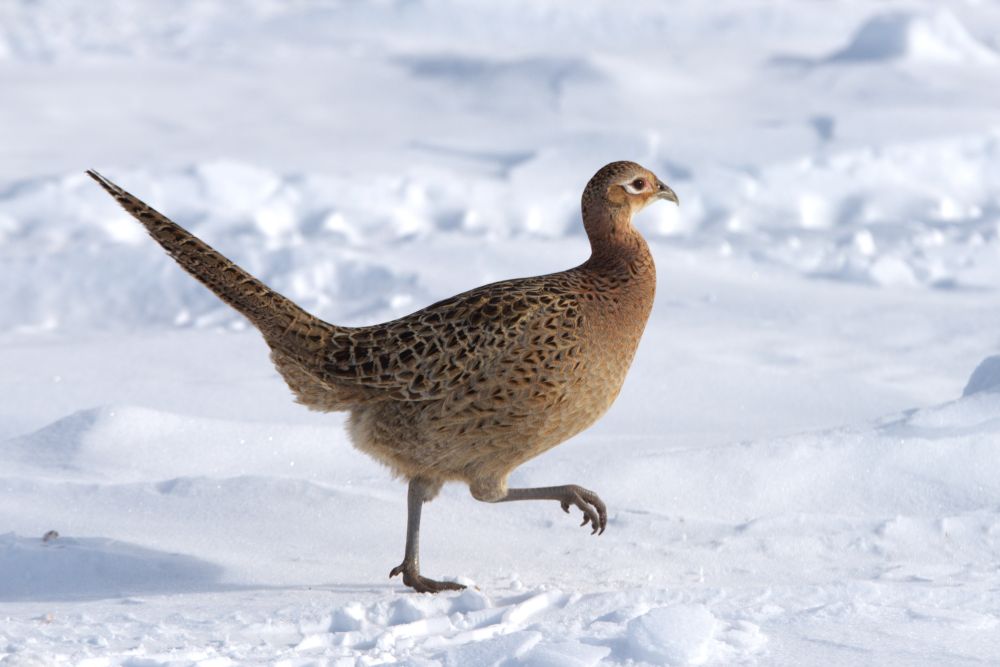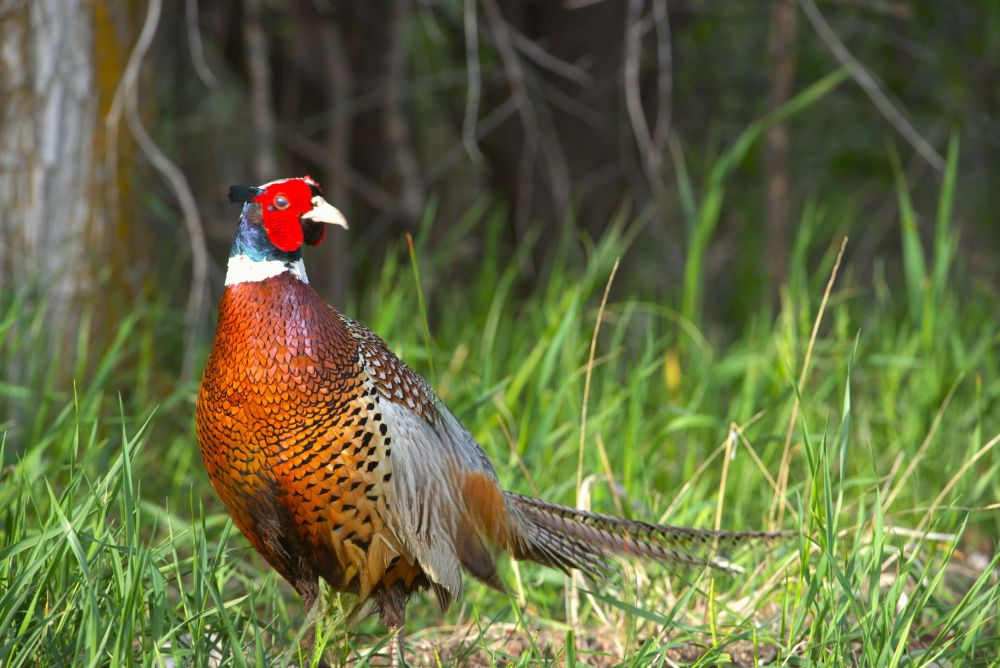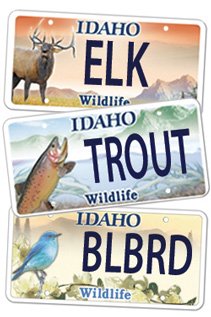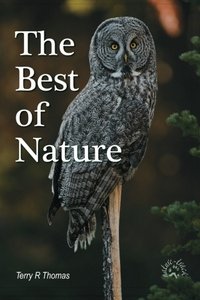Males and Females


Photos copyright Terry R. Thomas/nature-track.com.
Male (left) and female (right) ring-necked pheasant are much different in looks, almost to the point of seeming to be different species. Humans are even more different where thinking is concerned.
The male and female northern harriers sat near each other on a wire. The male was slate gray while the female was a more mottled brown. The biggest difference though, was in size. The female was noticeably larger, to the point that they almost looked like different species.
In much of the natural world, and in our human world as well, males are usually the larger of the two sexes. Called sexual dimorphism, differences between physical features of males and females of the same species, males and females are often remarkably different in other ways too. For instance, in species where sexual dimorphism is strong, say ring-necked pheasant, the male is not only larger, but is also wildly colorful, sports a long tail, and is more aggressive than the cryptically colored (camouflaged) female.
While larger males is the general rule with mammals, it is not always the case across the animal kingdom. As with the northern harriers, with most raptors the female is the larger of the two sexes. The angler fish, an ocean fish living at depths of down to 6,600 feet, takes sexual dimorphism to the extreme. The female grows to about 12 inches. However, the male is seldom more than half an inch long. Among amphibians such as frogs and salamanders, the female is often larger. The same is true for some reptiles such as turtles and snakes. However, with lizards and alligators, the males are larger.
Size differences are really a function of evolution driven by necessity. For large males, size is often a factor in which males get to breed. Bigger males win more battles and get to pass on their genes, including size. After a while, male size within the population has increased.
For females, if a larger size helps her to cope better with the rigors of pregnancy or caring for the young, then larger individuals will be more successful and will pass on more genes. Once again, the result is that female size within the population increases.
This sexual dimorphism stuff gets most interesting among humans though, where we can look beyond the physical differences and into the actual workings of the brain. It turns out that the classic self-help book, Men are From Mars, Women are From Venus, written in 1992 by Dr. John Gray, may be spot on, at least regarding its title. According to recent (2024) Stanford University research, the ways men’s and women’s brains work are completely different.
When neuro scientists used the latest technology to “map the neuro fingerprint” of a sample of 1500 college-aged men and women, they found that the data points showed all the female “fingerprints” in one corner and all the male fingerprints in the opposite corner of the graph. There was no overlap. These findings indicated that what goes on in a male brain at rest is significantly different than what goes on in a female brain at rest.
Further, when the researchers mapped “patterns of cognitivity,” they found that male patterns predicted male cognitive function (such as thought, visual perception, movement, and emotional regulation), but male patterns could not predict female patterns and functions and vice versa.
The bottom line is that men and women are different in very fundamental ways, one not better than the other just as a peach is not better than an orange, but different all the same. Treating men and women exactly the same is likely a recipe for a social train wreck at some point. Just as we appreciate the physical differences enough to maintain our species, we should celebrate the differences in the way men and women think, not try to homogenize them.
Help Idaho Wildlife
When we traveled across the state in October 2017, we visited most of the Idaho Department of Fish and Game wildlife management areas. Most of the vehicles we saw using the wildlife management areas did not have wildlife plates. Buying wildlife plates is a great way for non-hunters and hunters alike to support wildlife-based recreation like birding.
C'mon folks, let's help Idaho's wildlife by proudly buying and displaying a wildlife license plate on each of our vehicles!
See below for information on Idaho plates. Most states have wildlife plates so if you live outside Idaho, check with your state's wildlife department or vehicle licensing division for availability of state wildlife plates where you live.
And tell them that you heard about it from Nature-track.com!

Wildlife License Plates
Great news! as of 2024, there are three NEW designs for license plates. They still are bluebird, cutthroat trout and elk, but they are beautiful.
Idaho Wildlife license plates provide essential funding that benefits the great diversity of native plants and wildlife that are not hunted, fished or trapped—over 10,000 species or 98% of Idaho’s species diversity. Game species that share the same habitats (such as elk, deer, antelope, sage-grouse, salmon, trout) also benefit from these specialty plates.
No state tax dollars are provided for wildlife diversity, conservation education and recreation programs. Neither are any revenues from the sale of hunting or fishing licenses spent on nongame species. Instead, these species depend on direct donations, federal grants, fundraising initiatives—and the Idaho Wildlife license plates.
Both my vehicles have Bluebird Plates. I prefer the bluebird because the nongame program gets 70 percent of the money from bluebird plates, but only 60 percent of the money from elk and trout plates - 10 percent of the money from elk plates supports wildlife disease monitoring and testing programs (to benefit the livestock industry) and 10 percent from cutthroat plates supports non-motorized boat access.
Incidentally, in 2014, the Idaho Legislature denied the Department of Fish and Game the ability to add new plates or even to change the name of the elk and cutthroat plates (very specific) to wildlife and fish plates, a move that would have allowed for changing images occasionally and generating more revenue. It would seem that they believe that we Idahoans don't want a well funded wildlife program.
I think it is time we let the Legislature know that Idahoan support wildlife funding and that we would like to see these generic plates come to fruition.

"WOW. What a phenomenal piece you wrote. You are amazing." Jennifer Jackson
That is embarrassing, but actually a fairly typical response to my nature essays. Since The Best of Nature is created from the very best of 16 years of these nature essays published weekly in the Idaho Falls Post Register (online readership 70,000), it is a fine read. It covers a wide variety of topics including humorous glimpses of nature, philosophy, natural history, and conservation. Readers praise the style, breadth of subject matter and my ability to communicate complex and emotional topics in a relaxed and understandable manner.
Everyone can find something to love in this book. From teenagers to octogenarians, from the coffee shop to the school room, these nature essays are widely read and enjoyed.
Some of the essays here are my personal favorites, others seemed to strike a chord with readers. Most have an important message or lesson that will resonate with you. They are written with a goal to simultaneously entertain and educate about the wonderful workings of nature. Some will make you laugh out loud and others will bring a tear to the eye and warm your heart.
Readers Write:
"You hit a home run with your article on, Big Questions in Nature. It should be required reading for everyone who has lost touch with nature...great job!" Joe Chapman
"We enjoyed your column, Bloom Where Planted. Some of the best writing yet. The Post Register is fortunate to have your weekly columns." Lou Griffin.
To read more and to order a copy, click here or get the Kindle version
Copies are also available at:
Post Register
Island Park Builders Supply (upstairs)
Barnes and Noble in Idaho Falls
Harriman State Park, Island Park
Museum of Idaho
Valley Books, Jackson Wyoming
Avocet Corner Bookstore, Bear River National Wildlife Refuge, Brigham City, Utah
Craters of the Moon National Monument Bookstore, Arco, Idaho